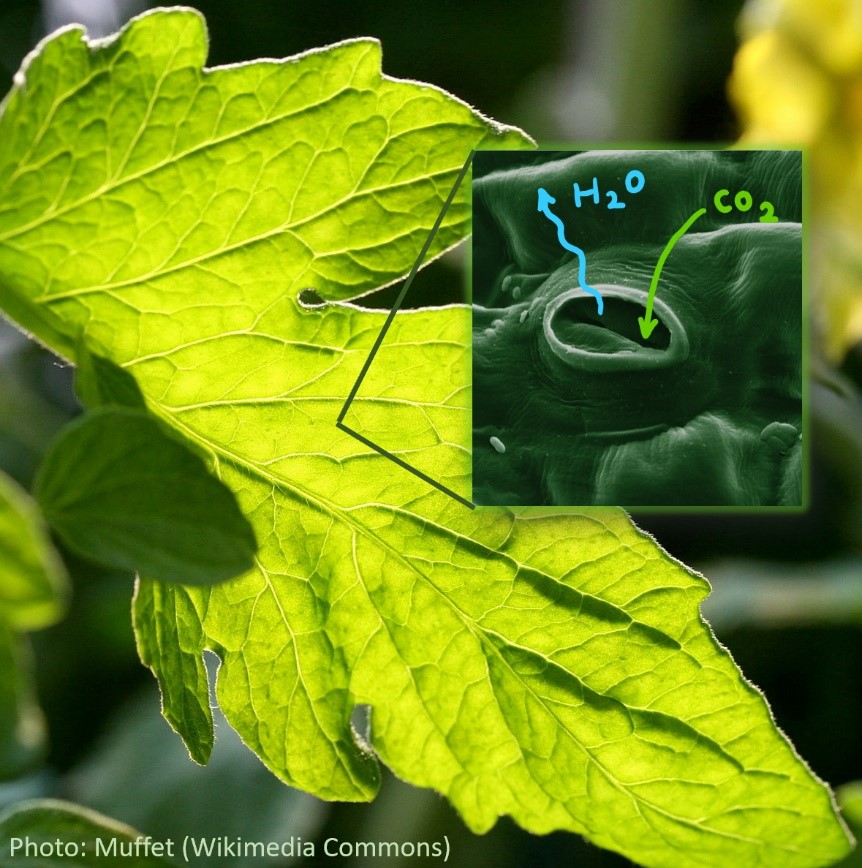
Jaideep Joshi highlights the results of a recent study in which he and his colleagues looked into the impacts of the novel environmental conditions that plants are exposed to today as a result of the changing climate.
Terrestrial plants remove a whopping 125 gigatons of carbon from the atmosphere every year by photosynthesis – that’s approximately the weight of a billion blue whales. While much of this carbon makes it back into the atmosphere, net carbon removal still amounts to 2.6 gigatons – a third of our annual fossil fuel emissions. The same plants together transpire 81,000 cubic km of water into the atmosphere every year – equivalent to the amount of water in the Caspian Sea. Transpiration by terrestrial forests accounts for 30% of the global water cycle – indeed, the Amazon Forest makes its own rain!
Plants have evolved different pathways by which photosynthesis can take place. A vast majority of plant species (85%) follow the C3 pathway, so named because the starting point is a molecule with three carbon atoms. This pathway dominates the plant kingdom because it is energetically most efficient (except in highly arid or hot conditions, where other pathways are favoured). Yet, it comes at a price. If C3 plants open their stomata – tiny valves on the leaf surface – to absorb CO2, they lose water through the same valves. And losing water means risking hydraulic failure and death, especially when the soil is dry. Therefore, C3 plants face a fundamental dilemma: should they open their stomata wide to absorb more CO2, or should they keep them closed to avoid hydraulic failure?
 © Muffet | Wikimedia Commons
© Muffet | Wikimedia Commons
Figure 1. CO2 uptake and loss of water vapor happen through tiny valves on the leaf's surface called stomata
How about dynamically controlling the stomatal opening, to maximize carbon uptake under wet conditions and to avoid hydraulic failure under dry conditions? After all, 70% of global forests are prone to at least some dry periods. So, are plants using some clever survival strategies? Indeed, plants have evolved diverse strategies for controlling their stomata, suited to the environments they live in. Under normal conditions, most plants keep the stomata open, even to the extent of operating dangerously close to their hydraulic thresholds. But under severe drought, survival becomes the prime concern – stomata close, and photosynthetic machinery is scaled down.
We have set out to develop a unified theory of plant photosynthesis and hydraulics that can predict how plants with given hydraulic characteristics respond to drought. A simple optimality principle holds the key – plants simultaneously control their stomatal opening and photosynthetic capacity to maximize profit. Profit equals revenue minus losses, measured in carbon currency. Carbon revenue is from CO2 uptake, and carbon losses stem from the real costs of maintaining the photosynthetic machinery and the prospective costs of hydraulic failure. Our theory predicts how carbon assimilation rate, stomatal conductance, leaf-internal CO2 concentration, water suction pressure in the leaves, and photosynthetic capacity acclimate to climatic and soil-water conditions. The figure below shows sample predictions for two species from different habitats – Eucalyptus pilularis, found in wet coastal areas of eastern Australia, and Eucalyptus populnea, found in semi-arid regions of interior Australia. The lines are theoretical predictions, whereas the points are observed data.
 © Joshi et al.
© Joshi et al.
Figure 2. Our optimality-based theory correctly predicts the photosynthetic responses of diverse species to progressive drought.
We tested our theory with previously published experimental data from 18 plant species from diverse biomes. With just two parameters, the theory explains a wide range of empirical observations in a simple way. It expounds why photosynthesis and transpiration diminish with declining soil moisture. It elucidates, for the first time, why the photosynthetic capacity of leaves decreases when soils become drier. It reveals why most plants operate dangerously close to their hydraulic thresholds. It accurately predicts, for the first time, the photosynthetic responses to drying air.
Climate change may give rise to novel environmental conditions that plants have not experienced before. Being based on eco-physiological processes and optimality principles, our theory is expected to scale to such out-of-sample environmental conditions better than statistical extrapolations. The theory can readily be plugged into global land-surface models. By capturing the synergistic effects of rising CO2 concentrations and rising rainfall variability under climate change, it could significantly improve projections of the global carbon and water cycles under future climate scenarios.
Reference:
Joshi, J., Stocker, B.D., Hofhansl, F., Zhou, S., Dieckmann, U, & Prentice, I.C. (2022). Towards a unified theory of plant photosynthesis and hydraulics. Nature Plants DOI: 10.1038/s41477-022-01244-5. [pure.iiasa.ac.at/18119]
Note: This article gives the views of the author, and not the position of the Nexus blog, nor of the International Institute for Applied Systems Analysis.